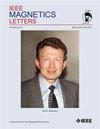镧取代Gd3Fe5O12调谐磁性能的实验研究
IF 1.1
4区 物理与天体物理
Q4 ENGINEERING, ELECTRICAL & ELECTRONIC
引用次数: 0
摘要
这封信涵盖了镧取代钆铁石榴石(GIG) (Gd3-xLaxFe5O12)的结构和磁性能,其中La离子在Gd位点被取代。x射线衍射分析表明,合成的样品具有立方晶体结构,镧取代使晶格常数增加。通过Williamson-Hall图分析估计晶体尺寸,发现当${x}$ = 0时,晶体尺寸从50.577 nm增加到${x}$ = 0.4时,晶体尺寸增加到67.343 nm。从纯GIG到la取代GIG,室温磁化值从0.162 emu/g增加到2.536 emu/g。当温度从565 K升高到573 K时,这些材料表现出铁磁性到顺磁性的相变,这是由于Fe3+离子之间的高超交换相互作用所致。除了相变外,室温下还观察到温度磁补偿。根据室温磁滞曲线估计了样品的矫顽力,显示出软铁磁行为。稳定的晶体结构、低磁补偿、低矫顽力场和高转变温度使这些材料适合用于通信器件。本文章由计算机程序翻译,如有差异,请以英文原文为准。
Tuning Magnetic Behavior of Lanthanum-Substituted Gd3Fe5O12: An Experimental Study
This letter covers the structural and magnetic properties of lanthanum-substituted gadolinium iron garnet (GIG) (Gd3-xLaxFe5O12), where the La ion was substituted at the Gd site. X-ray diffraction analysis suggested that the synthesized samples possess cubic crystal structure with an increase in lattice constant with La substitution. The crystallite size was estimated through the Williamson–Hall plot analysis and found to increase from 50.577 for ${x}$ ${x}$
求助全文
通过发布文献求助,成功后即可免费获取论文全文。
去求助
来源期刊

IEEE Magnetics Letters
PHYSICS, APPLIED-
CiteScore
2.40
自引率
0.00%
发文量
37
期刊介绍:
IEEE Magnetics Letters is a peer-reviewed, archival journal covering the physics and engineering of magnetism, magnetic materials, applied magnetics, design and application of magnetic devices, bio-magnetics, magneto-electronics, and spin electronics. IEEE Magnetics Letters publishes short, scholarly articles of substantial current interest.
IEEE Magnetics Letters is a hybrid Open Access (OA) journal. For a fee, authors have the option making their articles freely available to all, including non-subscribers. OA articles are identified as Open Access.
 求助内容:
求助内容: 应助结果提醒方式:
应助结果提醒方式:


